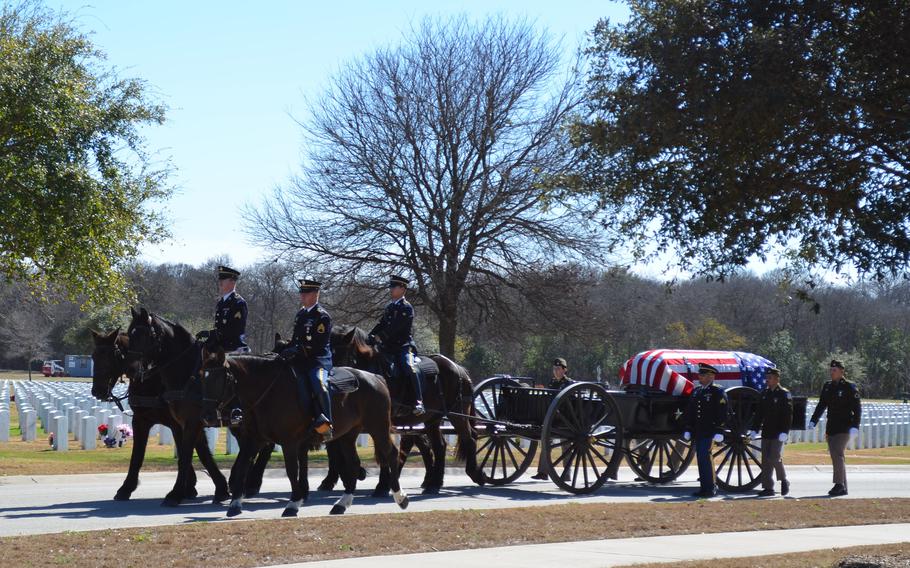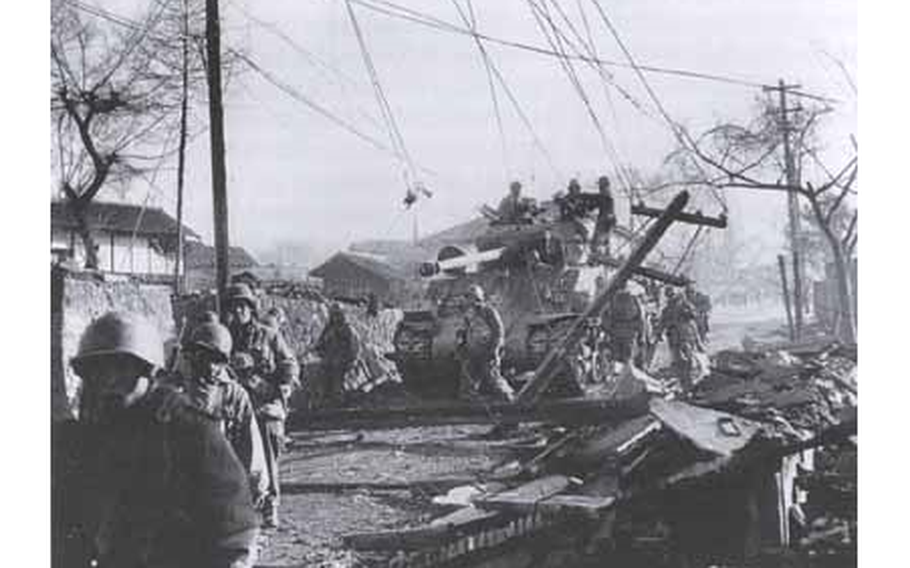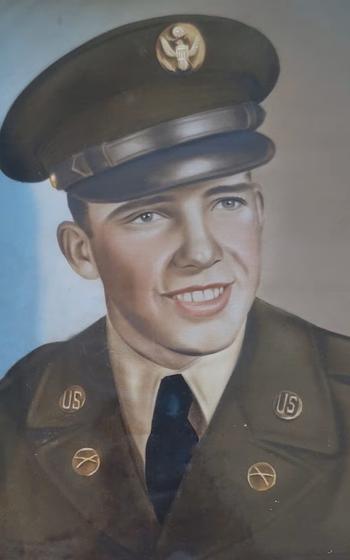
A casket carrying the remains of Pfc. Arthur Aaron Clifton arrives at Fort Sam Houston National Cemetery in San Antonio, Texas, Jan. 31, 2025. Clifton went missing Dec. 11, 1950, following the Battle of the Chosin Reservoir in the Korean War. His remains were identified in August 2024 by the Defense POW/MIA Accounting Agency. (Rose L. Thayer/Stars and Stripes)
FORT SAM HOUSTON, Texas — When 9-year-old Lydia Holland’s brother Arthur Aaron Clifton shipped off to Army boot camp in 1950, she handed him a quarter to get a Coke for the bus ride.
Clifton went from basic training, then to Korea with the 7th Infantry Division and never returned home. He became one of the more than 8,100 troops missing during the three-year war.
After 74 years, Holland said she is the only one of her parent’s six children still alive and she had given up hope that her brother would ever come home.
But the Defense POW/MIA Accounting Agency in August identified her brother’s remains using DNA that Holland had provided and she was able to bring him to Texas for burial.
Before a ceremony Friday at the Fort Sam Houston National Cemetery in San Antonio, Holland tucked another quarter into the jacket of Clifton’s service uniform.
“I’m glad to have it over with. I’m glad to have him put to rest,” she said, following the ceremony held beneath a cloudless blue sky.
Sitting next to her son Wade Holland, the now-84-year-old accepted a folded American flag, bullet casings from a 21-gun salute and the Order of the Bayonet award from the 7th Infantry Division.
Wade Holland, a retired Air Force senior master sergeant, told more than dozen people who gathered in the cemetery that the service was a unique experience. He never knew his uncle, yet he feels a strong connection to him, he told the gathering.
Clifton was a 17-year-old private first class when he went missing Dec. 11, 1950, on the arduous journey out of the Chosin Reservoir in North Korea. U.N. troops had been surprised by a large Chinese force about a week prior and were following the only road out of the region under constant attack from enemy forces.
Assigned to the division’s Headquarters Battery, 48th Field Artillery Battalion, Clifton was one of about 700 service members still missing from the battle. More than 7,500 American troops remain missing from entire war, which ran from June 1950 until July 1953.
Since 1980, DPAA has identified the remains of 713 Korean War veterans, said Jennie Jin, a forensic anthropologist with the Defense POW/MIA Accounting Agency in Hawaii.
“We have dedicated [Korean War] team of about 10 folks, and it’s the largest project in the laboratory for a single war,” she said. “We want to identify them as fast as we can and as best as we can.”
The Chosin Reservoir was a particularly brutal fight because of the sub-zero temperatures, said Peter Knight, director of historical studies at the U.S. Army Center of Military History. Chinese divisions attacked the 7th Infantry Division and the 1st Marine Division from Nov. 27-29, 1950. It was so bitterly cold that the morphine drips carried by medics froze and the bolt actions in rifles stopped working.
The Chinese units occupied the high ground on both sides of the road, leaving American units to form a perimeter and use their artillery with air support, Knight said.
“But the Chinese had so many more soldiers than they did, and they were able to attack in wave after wave of infantry assaults. Each time they’re [losing] more and more of the U.N. forces in that process,” he said.
U.S. and South Korean forces suffered more than 10,000 casualties in the fight around the reservoir. Eventually Lt. Col. Donald Faith, the officer in charge, decided his unit could not withstand this any longer and troops begin to make their escape down south to the town Hagaru-ri. They arrived Dec. 6 and then began a 50-mile march toward the port of Hungnam to be evacuated by ship. By that point, the 7th Infantry Division was down to about 500 troops, including Clifton.

U.S. soldiers with tank make their way through the rubble-strewn streets of Hyesanjin in November 1950. (DA photograph)
“The way they fought to escape from the reservoir and get out to the port of Hungnam is a testament to the metal of those troops because they were in a very less-than-ideal situation. They had to persevere and managed to get out of there alive to fight another day,” Knight said.
It was somewhere on that final stretch through enemy assaults that Clifton was last seen by his fellow soldiers.
Clifton, who enlisted from Los Lunas, N.M., most likely died from a gunshot wound to his body, Jin said.
His remains were collected from North Korea in 1954 during Operation Glory, which was an exchange of each countries’ dead. Fingerprinting was the primary source of identification at that time, which meant 867 unknowns, including Clifton, were buried in the National Memorial Cemetery of the Pacific in Honolulu, according to DPAA.
Identifications had been slowly ongoing during the years but in 2018 — with major advancements in identification technology — DPAA began the process of disinterring all the 652 service members still buried as unknowns in Honolulu.
DPAA works with families of the missing to collect DNA, which can be used to link remains to a certain person, as well as rule out others to narrow the field of possibilities, Jin said. About 90% of Korean War families have contributed DNA, but that 10% gap can slow down eliminations.
Clifton was singled out using DNA and by comparing a chest X-ray conducted on him when he enlisted to check him for tuberculosis to a chest X-ray of his skeletal remains, Jin said.
“It’s almost like a print, and it’s beautiful. They match so nicely,” she said. “We’re looking at the bone density [or] an interesting shape.”
Jin, who has been with DPAA since 2010, said bringing closure to families of the soldiers who fought in the Chosin Reservoir is particularly close to her heart. Her grandparents boarded a U.S. Navy ship that evacuated civilians from the region during the war.
“When I look at these remains, Clifton was probably the same age with my grandfather, who is still alive and very well in Korea. He’s 97 years old,” Jin said. “Without that help, I would not be here today.”
Those men who survived from Clifton’s unit were part of that evacuation. In total, 105,000 military personnel, 91,000 Korean civilians, 17,500 tanks and 350,000 tons of supplies were pulled from Hungnam in more than two weeks. The 7th Infantry Division troops were the last out on Dec. 24, 1950.
Wade Holland and his mother said they hope their closure brings continued hope to those families still waiting for their loved one to be returned home to them.
“Any other families that are in this situation, know that the Army is trying. They’ve got a lot of work ahead of them,” he said. “They are working it and trying to get some closure for everybody.”

Pfc. Arthur Aaron Clifton, 17, went missing on Dec. 11, 1950, following the Battle of the Chosin Reservoir in the Korean War. His remains were identified in August by the Defense POW/MIA Accounting Agency and he was buried Jan. 31, 2025, at the Fort Sam Houston National Cemetery in San Antonio, Texas. (Photo provided by DPAA)